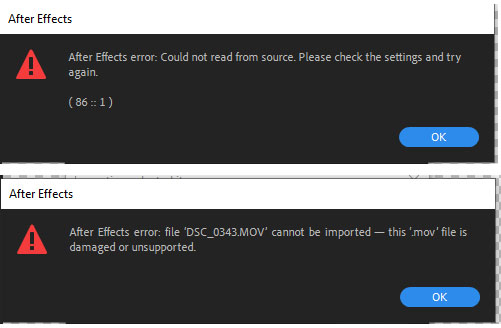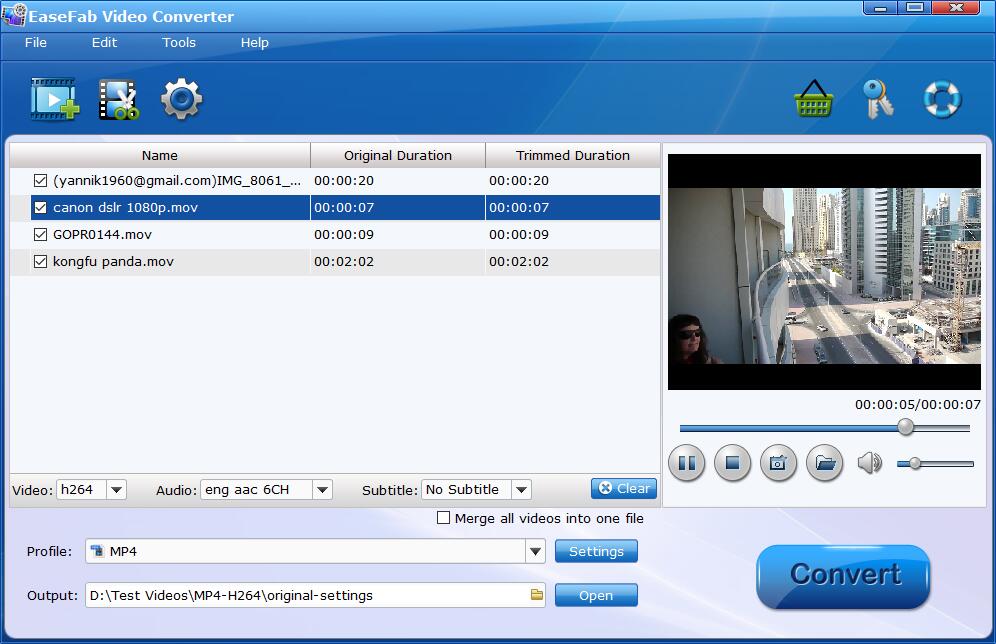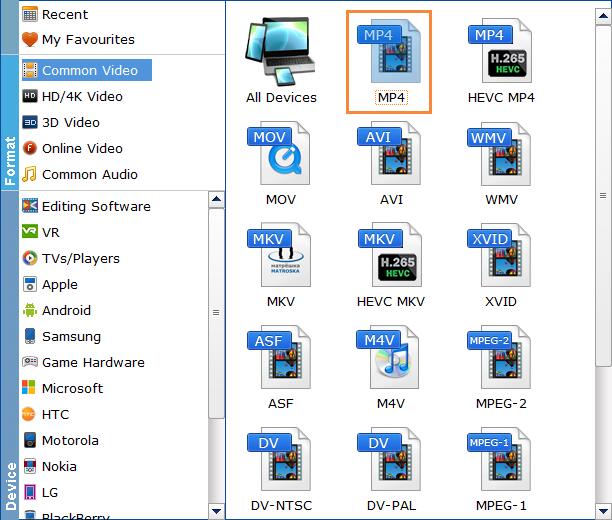Posted by George Shelley - Sep 09, 2021 | Contact Author![]()
[Solved] Why & How to Fix After Effects Won't Import .MOV Files
After Effects rejects to import .mov files created by iPhone, GoPro, Canon canmer, DJI drone, iMovie, and more? Here you will find the possible causes and solutions to fix this issue.
"I have a weird problem with importing .mov files into Adobe After Effects CC. I already have one .mov file imported in the project, but when I try to import another .mov file, it says the file type is unsupported. I don't get it, can anyone help me?"
According to Adobe official website, After Effects natively supports MOV QuickTime format. However, you may have the same questions listed above when using it. The error message goes like, "This file is damaged or unsupported", "Codec missing or unavailable" and "32-bit QuickTime support ending". Or After Effects only import audio from MOV files for you. You can only add the Apple QuickTime .mov file to the timeline of After Effects as an audio track, instead of a video track. Just sound, no video.
If you are currently using an older version of the Adobe software, maybe an upgrade of the Adobe version could help. Are you still stuck with unsuccessful attempts? Read on to find the possible causes and how to solve "can't import MOV to After Effects" error.

Why some MOV video files cannot be imported or opened in After Effects?
There are various potential reasons might result in MOV not importing to After Effects issue and below are several possible causes:
1. Your After Effects version is tool old to support the MOV files. If you're using an old version, you can upgrade AE to the newest version to have a try.
2. Your MOV files are corrupted. You can check whether your MOV file can be recognized and played properly using other programs. If not, repair it using a professional video repair tool.
3. Incompatible codecs or some required codec missing. Adobe official website points out that not all QuickTime codecs are supported by default and that some codecs require third-party components. You can follow the solution 2 to install QuickTime or require codecs to try fixing the issue.
4. Hardware configurations are too low to support 4K MOV footages, especially 4K MOV shot in high frame rate like 60FPS.
5. MOV file with variable frame rate. Although After Effects had an update to support VFR, it still can't deal with most of VFR videos. You need to convert your videos from variable framerate to constant framerate using a converter, such as EaseFab Video Converter. This probably solves your problem.
Analysis: Broadly speaking, the major cause is that some required codec is missing or codec incompatibility so that the file format is not supported. After Effects does support MOV file format, but MOV is a container format which can use MPEG-4, MJPEG, H.264, HEVC, GoPro CineForm, or other video codec for compression. To import MOV files successfully, AE needs to be compatible with the specific codecs used in the MOV files. If not, you'll experience MOV importing error. Therefore, transocding MOV file should be a very helpful method and it's the the most effective yet easiest solution recommended by us.
Codec missing is the major cause for "Can't Import MOV File":
The Key: Convert Problematic MOV to a Fully Adobe-Compatible Format.
As a result of the analysis above, the most practical approach to fix After Effects not importing MOV problem is to convert MOV codec or format. If you have Adobe Media Encoder, you can use it for video conversion. If you don't have that tool or can't manage to convert unrecognized MOV files to desired format with Media Encoder, you might as well try an easier-to-use yet powerful video converter and decoder - EaseFab Video Converter.
It makes an easy work of transcoding MOV to After Effects supported MOV H264, MP4, AVI, MPEG-2, etc to fix MOV codec incompatibility or missing issues. As for the video quality, don't worry too much. With the constantly updated conversion algorithm and the advanced high quality engine, it guarantees you the output MOV video with up to 98% quality reserved, wrinkles or freckles in image still clear enough to count.
Preparation: Free Download EaseFab Video Converter to Convert MOV to Editing-Friendly Codec
● Support MOV video files created by iPhone, GoPro, Canon camera, DJI drone, iMovie, Final Cut Pro, and more at any resolution, frame rate and bit rate.
● Transode media files to After Effects compatible codec and format for natively importing and editing.
● Easy editing experience: cut, crop, merge, add subtitles and more.
● Support advanced GPU acceleration to relieve the burden from CPU.
How to decode MOV to After Effects supported codec/format
In the following guide we take EaseFab Video Converter (Windows version) as an example. Mac version shares the same steps.
Step 1. Launch EaseFab Video Converter on your computer. Click Add Video button to import the MOV video(s) that has an import issue in After Effects. Dragging and droppping works too. (Note: batch conversion is supported, so you can several mov videos to the program to convert at a time.)

Step 2. Click the Profile bar at the bottom. Choose a format preset that After Effects can support, for example, MP4 (codec: h.264+aac), AVI and MPEG-2 from Common Video category. And MP4 encoded by H.264 is recommended. Optionally, you can click the Settings icon to adjust frame rate, resolution, bit rate, and more.

Step 3. You can cut, crop, merge, rotate, fix A/V out-of-sync problem and make some easy video edits in a linear manner with EaseFab Video Converter.
Step 4. Hit Convert and it will begin fast video decoding, conversion and processing your MOV video at one go.
Once done, import the resulting encoded .mov file to Adobe After Effects will be an easy process.
Possible Solution 2: Install QuickTime or Required Codec to Fix Can't Import MOV to After Effects Error.
QuickTime comes with many popular and general-purpose codecs, so installing QuickTime may be able to resolve import error caused by missing codec. After installing QuickTime, restart your After Effects and check if it can import MOV video files now.
Step 1: Download QuickTime on your PC. Note: QuickTime 7 for Windows is no longer supported by Apple.
Step 2: Install QuickTime:
● 1. You should read its License Agreement carefully, and scroll down to see the rest of the agreement.
● 2. You should choose the setup type between Typical and Custom that should be decided by whether you are a common user or advanced user.
● 3. Change the Destination Folder from Disk C to other disk to save space in C, and click Install.
Step 3: After finish installing QuickTime, you have to restart your After Effects.
Step 4: Check Whether it can import MOV video files.
● Important Notice: QuickTime has been officially discontinued on Windows, so there supposedly is a security risk. Windows 10 users may find it doesn't work. This is because Windows 10 does more security things than Windows 7 and Windows 8.1 do.
If you can't install QuickTime or still can't import MOV to After Effects after installing QuickTime, you can download and install required codec from established sources to have a try. Before doing that, you'd better backup all your files because installing a new codec typically causes some video or audio files to become unreadable.
One more thing, Adobe officially suggests not downloading codec pack software to avoid codec conflicts.
Possible Solution 3: Rename the File Extension to Fix MOV File Not Supported by After Effects Error.
This trick does get many users out of trouble. However, it isn't guaranteed to work. Some people still can't load files to After Effects successfully.
"I changed it to both avi and mp4. MP4 has an audio sync issue and avi pops open a windows with a damage or unsupported format. "
Some people even are not allowed to rename the file extension for some reason.
Final Words:
The major cause that After Effects fails to import MOV files is that some required codec is missing and the file format is not supported. Therefore, transocding MOV file using EaseFab Video Converter is the the most effective yet easiest solution recommended by us.
Other Useful How-to Guides & Tips
Final Cut Pro Won't Import an MOV file? Fixed
Trouble importing an MOV file into Final Cut Pro X or FCP 7/6? Being puzzled? Here you'll find the answer and learn how to import MOV video to Final Cut Pro with ease.
[Solved] Can't Import or Edit MOV Files in Sony Vegas Pro
If you're facing problems editing MOV in Sony Vegas Pro, the easy option is to convert MOV to a Sony Vegas compatible format like WMV or MPEG-2.
[Solved] How to Fix PowerPoint Cannot Insert QuickTime MOV Files?
Got a problem with embedding a QuickTime .mov file into PowerPoint? Here you will find the possible reasons and two easy methods to fix the problem.
Troubleshoot Adobe Premiere Pro MOV File Import Failure Error
Can't import MOV files to Premiere Pro 2020/2019/2018 for editing? Here you'll find the answers and learn how to import MOV to Premiere Pro with ease.
Copyright © 2025 EaseFab Software Corporation. All Rights Reserved.

